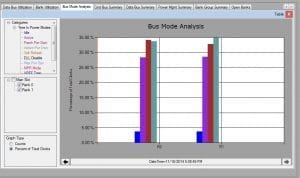For DDR4 there are 11 different modes and these metrics are Rank based. These include the following: Reset, Idle, Active, Precharge Power Down, Active Power Down, Maximum Power Down Mode, Self-Refresh, DLL Disable, Write Leveling, MPR Mode (also known as Read leveling or Read training), and VREF Training Mode. To make the best use of this measurement these modes should be represented by the amount of time spent in each mode as Time (in seconds), or percentages (time spent in mode divided by elapsed time).
WHY Measure this?
- Gives engineers a relative measure as to how often various modes are entered and for what length of time the system spends in these overhead states.
- General Verification of the JEDEC specified modes of operation.
- To quickly look for infrequent events.
- A quick analysis of no boot scenarios.
- To isolate problems in Memory Validation.
Power Management is included in this metric so it may seem like a redundant measurement but the new insight gained is in the additional modes and how they all interrelate. Below is an example measurement on our example DDR4 system. The real insight is gained by the second by second playback to show the movement of the system in and out of these various modes.

Summary
Due to the advancements in FPGA technology, FPGA based test equipment can now count every cycle, transaction and time spent in almost all important events. This allows memory subsystem performance measurements to be expanded to give greater insight into DDR4 performance. Bus Mode Analysis is one of those new metrics that can be tracked on any DDR4 DIMM or SODIMM bus.

